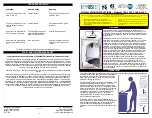
INSTALLATION, OPERATION AND MAINTENANCE INSTRUCTIONS
SYDNEY | MELBOURNE | BRISBANE | PERTH | AUCKLAND
Australia
1300 788 778 www.rba.com.au |
New Zealand
0800 722 111 www.rbagroup.co.nz
10 of 20
2.1 Installing the Flush Valve Assembly
• Identify that all components are in the packaging. Three components are included in the packaging:
i)
An isolating ball valve and strainer combination with fitted 'Nautilus' Solenoid;
ii)
Connecting nut and vacuum breaker assembly;
iii)
PVC loose nut cap and lining.
• Flush the water supply lines thoroughly to remove any dirt or debris.
• Fit the flush valve in the required position maintaining a minimum 700mm distance between the outlet of the vacuum
breaker and the centre line of the lush pipe connected to the WC pan inlet.
• It is recommended that a loose nut or union connection be used at the inlet ball valve to facilitate ease of assembly
removal should this be required.
• Once installation heights have been established, fit the Connecting Nut and vacuum breaker assembly to the ball valve
and 'Nautilus' Solenoid.
• Fit the PVC cap and lining to the flush pipe, tightening the loose nut onto the male outlet thread of the vacuum breaker.
Ensure rubber seal is seated on PVC pipe.
• Connect flush pipe to the WC fixture.
• Turn water supply on and check for leaks. Note: A small amount of water may pass through the 'Nautilus' Solenoid
valve when power is not connected to it. The correct function of the 'Nautilus' solenoid should see pressure equalise
across the diaphragm causing the valve to remain closed.
• Connect 'Nautilus' Solenoid to the piezo’s for half and full flush along with Electronic Controller and Power Pack is
required to complete the installation
• Once commissioning has been completed, test the system by pressing the half flush piezo and checking that the valve
closes off.
• Repeat this test with the full flush piezo by pressing the full flush piezo and checking that the valve closes off.






































